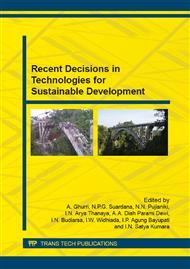p.139
p.145
p.151
p.157
p.163
p.169
p.179
p.186
p.193
The Importance of the Physical Boundary Line onBali Coastal Tourist Resorts
Abstract:
This paper is to propose a concept of boundary line onBali coastal tourist resorts in which the aim of this concept is to offer aclear boundary between private owners and public space and to avoid dispute on the land ownership between privates and the state. The rationale behind this concept is because there isa serious problem in these areas resulted from many interests and activities being in conflict as result they become a very sensitive space. Beach utilisation without planning, takes place creatinga conflict of interest which tends to bringnegative impacts on social, economic, politic and environmental aspect.According to research, the areais impacted upon by physical problemsemerging not only from the offshore but also the onshore sources. If there is no solution immediately, it will bring serious implication for social and environmental cost which will adversely affect all parties and Bali as a whole. Therefore, the boundary line concept is expected to be one of the most effective solutions to solve the problem, and in turn it becomesamodel to sustain the areas as the most popular tourist attractions in Bali.
Info:
Periodical:
Pages:
163-168
Citation:
Online since:
July 2015
Authors:
Keywords:
Price:
Сopyright:
© 2015 Trans Tech Publications Ltd. All Rights Reserved
Share:
Citation:


